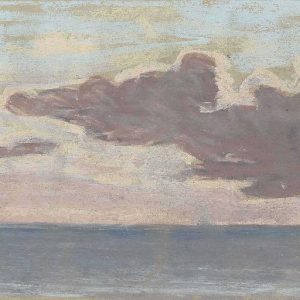Claude Monet’s “Bridge over a Pond of Water Lilies” is a stunning masterpiece that has captivated art enthusiasts for over a century. Painted in 1899, this iconic work is part of Monet’s renowned “Water Lilies” series, which showcases the artist’s fascination with the interplay of light, color, and nature. The painting invites viewers to immerse themselves in the serene beauty of Monet’s famous garden and water lily pond in Giverny, France.
Measuring 36 inches by 29 inches (91.4 cm x 73.7 cm), “Bridge over a Pond of Water Lilies” is an oil painting on canvas that exemplifies Monet’s pioneering Impressionist style. The composition features a charming wooden bridge arching over a tranquil pond filled with luminous water lilies. The bridge, known as the Japanese Bridge, was a central feature in Monet’s garden and a frequent subject in his paintings.
One of the most striking aspects of the painting is Monet’s masterful use of color. The canvas is filled with a vibrant palette of green, yellow, and orange hues, which bring the scene to life. The lush foliage surrounding the pond is rendered in various shades of green, from the deep, rich tones of the leaves to the brighter, more yellowy greens of the grass. The water lilies themselves are a symphony of pinks, whites, and purples, their delicate petals floating serenely on the pond’s surface.
Monet’s brushwork in “Bridge over a Pond of Water Lilies” is a testament to his Impressionist technique. The artist employs short, quick brushstrokes to capture the fleeting effects of light and color on the landscape. The result is a canvas that seems to shimmer and dance with energy, as if the scene is constantly shifting and changing before our eyes. This sense of movement is further enhanced by the reflections in the water, which create a mesmerizing interplay of light and shadow.
The composition of the painting is another element that showcases Monet’s artistic genius. The Japanese Bridge is positioned slightly off-center, creating a sense of asymmetry that adds visual interest and dynamism to the scene. The bridge also serves as a focal point, drawing the viewer’s eye into the heart of the composition and inviting us to explore the lush, dreamlike world of Monet’s garden.
Monet’s fascination with Japanese art and culture is evident in “Bridge over a Pond of Water Lilies.” The Japanese Bridge itself was inspired by the traditional wooden bridges found in Japanese gardens, and Monet’s use of bold, flat planes of color and asymmetrical composition echoes the aesthetic principles of Japanese woodblock prints. This fusion of Eastern and Western artistic traditions is a hallmark of Monet’s later work and contributes to the timeless appeal of his “Water Lilies” series.
Beyond its purely aesthetic qualities, “Bridge over a Pond of Water Lilies” also holds a deeper philosophical significance. The painting can be seen as a meditation on the relationship between humans and nature, and the search for harmony and balance in our lives. The bridge, a man-made structure, seems to blend seamlessly into the natural landscape, suggesting a symbiotic relationship between the two. The tranquil, almost dreamlike atmosphere of the scene invites contemplation and introspection, encouraging viewers to find moments of peace and beauty in the world around them.
The enduring popularity of “Bridge over a Pond of Water Lilies” is a testament to its universal appeal. The painting has been housed in several prestigious institutions, including the Metropolitan Museum of Art in New York and the National Gallery in London. It has inspired countless artists, writers, and thinkers, and continues to captivate new generations of art lovers around the world.
In many ways, “Bridge over a Pond of Water Lilies” encapsulates the essence of Monet’s artistic vision. It is a celebration of the beauty and wonder of the natural world, a testament to the power of light and color, and a meditation on the human experience. Through his innovative use of brushwork, composition, and color, Monet invites us to see the world through his eyes, to find joy and solace in the simple, fleeting moments of everyday life.
In conclusion, in addition to being one of Monet’s most well known works, “Bridge over a Pond of Water Lilies” is a true masterpiece of Impressionist art, a painting that continues to inspire and delight viewers over a century after its creation. Its enduring legacy is a testament to Monet’s genius and the universal appeal of his vision. Whether you are a seasoned art connoisseur or simply someone who appreciates the beauty of the natural world, this painting is sure to leave a lasting impression, inviting you to find your own moments of tranquility and wonder in the world around you.
It is currently on view at The Met in NY City.












